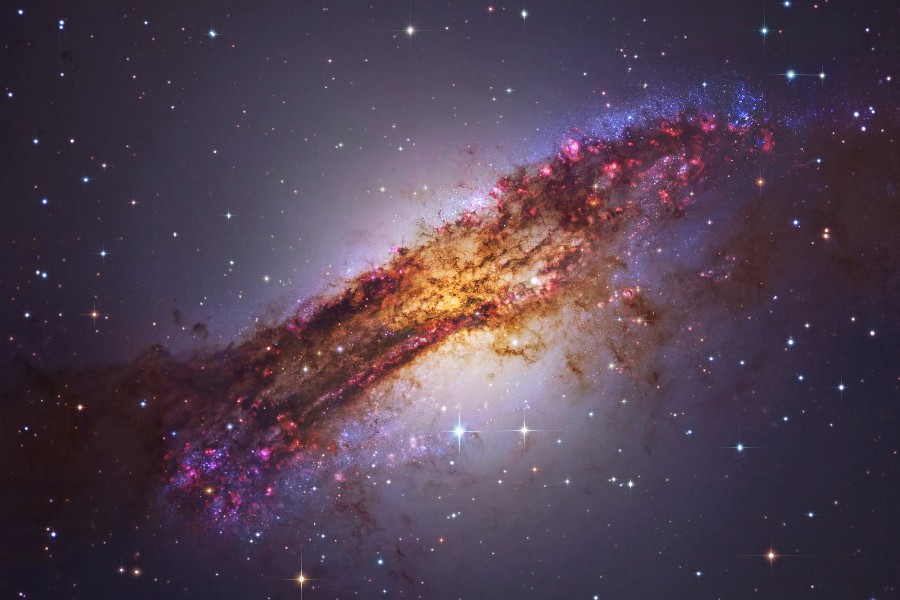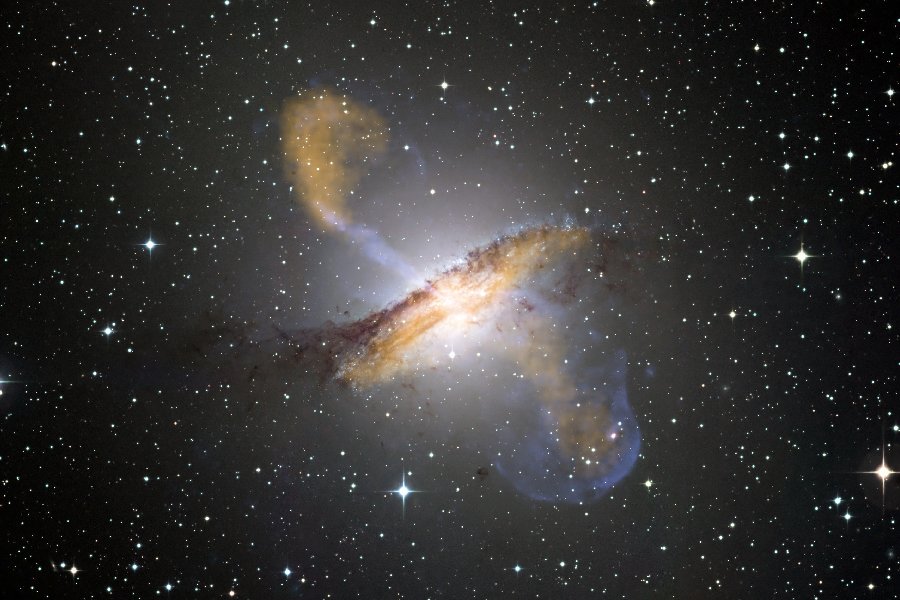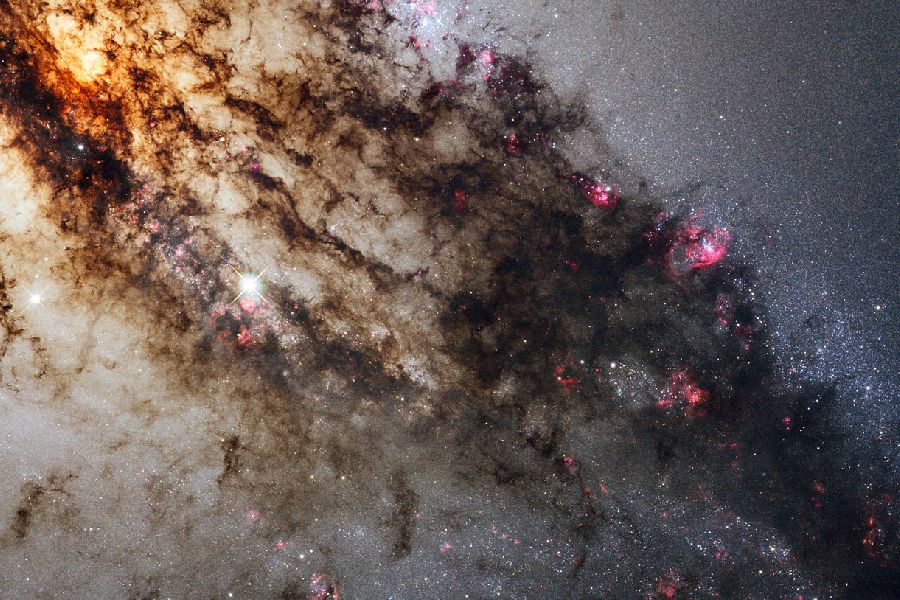Among the many galaxies visible in the night sky, one relatively close neighbor exhibits intriguing and extreme properties unseen elsewhere. Centaurus A galaxy shows striking dark dust lanes that bisect its core and intense jets streaming out from its nucleus at nearly the speed of light.
This remarkable neighbor exhibits chaotic activity well beyond typical galaxies. Its dramatic outbursts have attracted intense astronomical investigation across the electromagnetic spectrum to unravel why Centaurus A unleashes such immense energy relative to its more sedate galactic kin.
So, we will explore Centaurus A and its unique, violent stellar explosions that create the highest energy cosmic rays. Let’s get started!

Centaurus A Galaxy
Centaurus A galaxy (NGC 5128) results from the collision of a spiral and elliptical galaxy. Distinctive for its dark dust lane, it houses a powerful active galactic nucleus with a supermassive black hole, emitting strong radio, X-ray, and gamma-ray radiation.
Proximity to Earth and captivating features make Centaurus A a significant target for astronomers. It sheds light on galaxy formation and the behavior of supermassive black holes.
Centaurus A – The closest radio galaxy
Centaurus A is the closest radio galaxy to Earth at a distance of only 13 million light years away. Its proximity and bright emissions across bands from radio to gamma rays have made Centaurus one of the most studied extragalactic sources.
Centaurus A possesses a striking dusty lane, cutting through its center and emitting powerful jets. This makes it strange compared to more ordinary elliptical galaxies.
As the nearest galaxy with an active galactic nucleus, Centaurus A enables detailed multi-wavelength observation. This observation examines phenomena like relativistic jets from a supermassive black hole and associated cosmic ray acceleration.
Moreover, its accessibility and energetically intense emissions have focused major telescope investigations. These investigations seek to understand the exotic physics governing this remarkable neighborhood galaxy.
Characteristics of Centaurus A
Location and constellation
Centaurus A resides in the southern night sky within the namesake Centaurus constellation. Its proximity lies in the direction of the closest grouping of external galaxies gravitationally centered around the Milky Way, known as the Local Group.
Size comparison
At just 60,000 light years in diameter, Centaurus A is estimated to be one-fifth the size of the Milky Way’s expansive celestial disk. However, what it lacks in size, this galaxy more than compensates through energetic luminosity.
Extreme luminosity
Blazing with the strength of 100 billion suns, Centaurus A holds the title of the brightest radio galaxy visible in the night sky to the naked eye. No other galaxy outshines its visible brightness from a vantage point outside our own.
Hybrid classification
Centaurus A unveils a remarkable combination of elliptical and spiral galaxies merging. Its distinctive spherical symmetry is adorned with intertwined dark dust lanes that span its center. This makes its morphology abnormal compared to the more uniform types of nearby elliptical or spiral galaxies.
Anatomy of Centaurus A
At the blazing heart of Centaurus A lies a tremendously supermassive black hole 55 million times the Sun’s size. This central engine accretes matter into discs, blasting out plasma jets near light speed as material faces intense relativity. The galaxy also hosts abundant star-forming regions along its spiral arms and halo, where new stellar nurseries shine against older stars.

An insatiable cosmic engine
The heavyweight black hole hiding within Centaurus A weighs in about 55 million solar masses, placing it among the highest tiers in terms of mass. Surrounded by a swirling accretion disc, this voracious engine consumes any clouds or stellar debris that wander too close to its clutches, unleashing jets near light speed.
Furthermore, NASA’s Chandra X-ray Observatory has captured point-like dual jets firing out perpendicular from the galaxy’s nucleus, indicating the black hole impacts scales far beyond. Centaurus A gives unique insights into connections between galactic nuclei and their environments forged by hungry cosmic giants.
Stellar nurseries dot the dusty arms
Within Centaurus A’s spiral arms, cold and dense clouds condense, forming rich stellar nurseries that actively give birth to new star systems. Gravity compresses these molecular knots, initiating fusion within embryonic systems and causing them to heat up and eventually shine as the latest stars.
Also, the outer halo hosts more than 250 ancient globular clusters, contrasting the hot, young stars scattered along the inner edges of the dust band, which traces new enrichment. Spanning 60,000 light years, the galaxy’s history, extending beyond 13 billion years, is marked by ample raw materials that sustain successive generations of stars.
The Enigmatic Black Hole
Supermassive black holes occupying the hearts of large galaxies like Centaurus A contain tremendous mass. They range from millions to billions of times our Sun’s.
These represent the densest single objects known. They possess such monumental gravity that even photons of light cannot escape if passing too close to their boundary, called the event horizon. Matter, light, and time itself become terminally trapped and compressed by the sheer density locked within.
To visualize scale, our entire solar system would fit inside Centaurus A’s event horizon over 300 million times if centered on the Milky Way’s black hole. The forces surrounding supermassives make them the ultimate gravitational potential wells, accelerating surrounding gases and magnetic fields to portions of light speed.
Extreme gravitational forces
The core black hole of Centaurus A alone has enough gravitational pull to propel materials circling its accretion disc at incredible speeds. Visible jets unleashed near light speed blast out for thousands of light years above and below the galaxy’s axis.
Energetic beams collide with interstellar material, which creates expanding radio lobes and particle interactions. This process generates the highest energy cosmic rays known through shock acceleration.
Measurements indicate Centaurus A’s jets contain magnetized plasma traveling at approximately half the speed of light. Magnetic fields and particle interactions likely play crucial roles in the collimation, acceleration, and propagation of energetic jets triggered by matter accretion.
However, determining the ultimate power source driving these relativistic jets remains an intense study with wide-ranging implications.
Radio Lobes
Giant lobe structures stretching far outside Centaurus A emit intense radio waves. These form as jets inject hot plasma tracks interacting with galactic gas clouds.
Consequently, Centaurus A’s jets inject magnetized plasma into space. This plasma complicates interstellar medium interactions, driving shocks and accelerating particles that produce detected radio emissions. So, tracking lobe changes gives insight into jet properties and galaxy merger history.

Star Formation in Centaurus A
Reserves of cold, dense molecular clouds have collected along the prominent dust bands stretching across Centaurus A’s center. Gravity pulls on hydrogen atoms in these dark filaments, compressing clouds into stellar nurseries, birthing new stars, and illuminating the galaxy.
So, the process enriches Centaurus A with its history of emerging young stars and planetary systems. Despite Centaurus A’s age of more than 100 billion years, these dusty features span tens of thousands of lightyears and are rich in present star formation.
The new stars tend to lie embedded along the inside edges of the bands rather than evenly mixed, hinting at the dynamic history shaping them over time. Some young emerging clusters contain extremely massive luminous stars 30 times our Sun’s mass destined for swift stellar evolution.
Sculpting a hybrid galaxy’s appearance
Intense contrast visibly sets Centaurus A’s older, reddish giant stars apart. Distinct patches of hot blue stars are being born lately along the transverse lanes and in spiral arms.
The star formation history dichotomy sculpts its unusual hybrid structure between elliptical classification and patchy spiraled disk features. This provides continual gaseous enrichment, concentrating stellar nurseries inside those zones today.
However, if smoothed out evenly over galactic history, Centaurus A may have resembled a barred lenticular galaxy instead.
Interaction With the Centaurus Cluster
Its notable members, the Centaurus Cluster and Centaurus A engage in dynamic gravitational interactions. These forces have shaped Centaurus A’s structure, triggering a merger between a spiral and elliptical galaxy, evident in its unique appearance.
Tidal effects from interactions induce features like tidal tails, while the cluster’s gravitational pull contributes to the galaxy’s extended radio lobes. Galaxy movement within the cluster also leads to gas stripping, affecting Centaurus A’s star formation.
Hence, the interplay between Centaurus A and the Centaurus Cluster illustrates the profound influence of gravitational dynamics on galaxy evolution and structure. This offers valuable insights into the complex processes occurring within galaxy clusters.
Historical Significance
- First observed by James Dunlop in 1826, Centaurus A’s mysteries unfolded through history.
- John Herschel cataloged it as a nebula in 1847.
- Martin Ryle and Antony Hewish, in 1954, detailed its radio structure.
- In the 1970s, infrared studies by Gerry Neugebauer and Robert Leighton revealed its dusty nature.
- X-ray observations in 1979 confirmed an active galactic nucleus.
- Hubble’s 1990s images exposed intricate details, affirming its peculiar elliptical galaxy status.
Viewing Centaurus A
- Location and season – Choose a dark sky site away from light pollution. Centaurus A is visible from the Southern Hemisphere and is best observed during its highest elevation, typically during Southern Hemisphere winter (May to September).
- Telescope size – While Centaurus A is visible with smaller telescopes, a medium to large aperture telescope (8 inches or more) provides better details of its intricate features.
- Eyepiece selection – Use a low-magnification eyepiece to capture the galaxy’s overall structure and a higher magnification eyepiece for closer views of specific details.
- Filters – Consider using a nebula or broadband filter to enhance contrast and bring out faint details, especially in the galaxy’s dusty lanes.
- Dark adaptation – Allow the eyes to adapt to darkness for at least 20 minutes before observing. This enhances the ability to perceive faint details.
- Reference sky charts – Familiarize with Centaurus A’s location using star charts or astronomy apps to locate it accurately in the night sky.
- Astrophotography – Capture Centaurus A’s beauty through astrophotography. Use a camera with long exposure capabilities, and consider stacking multiple exposures for improved image quality.
Conclusion
As we wrap up our exploration of the fascinating Centaurus A Galaxy, we hope readers will experience a renewed sense of wonder. This wonder extends to the mysteries unfolding in our stellar neighborhood beyond the Milky Way.
Centaurus A offers unique accessibility, from deciphering the sequences that trigger powerful jets launched at near-light speed from deep within its supermassive core to tracing the ongoing star formation that sculpts features in transition.
Additionally, inspiration can be kindled by uncovering the significant facets that distinguish the intriguingly hybrid Sentinel Galaxy, shining millions of light years away. It is crucial in pushing the frontiers of our understanding as we decode the spectacular forces shaping such extragalactic leviathans within our celestial horizon.
